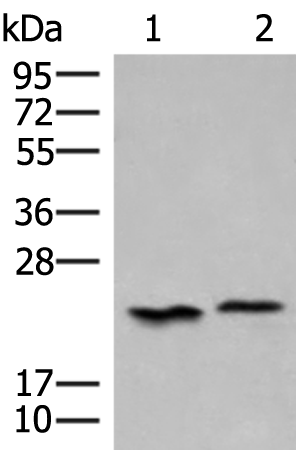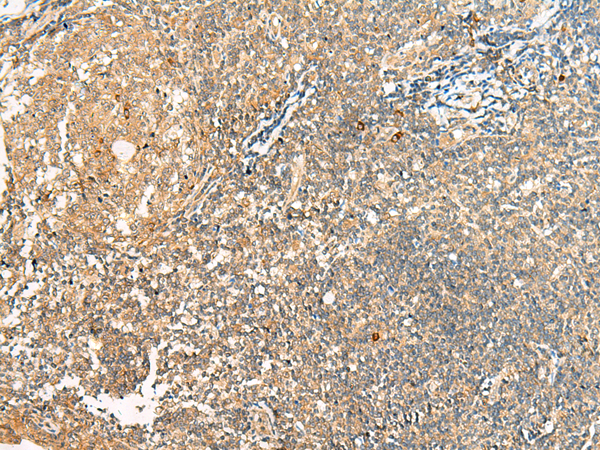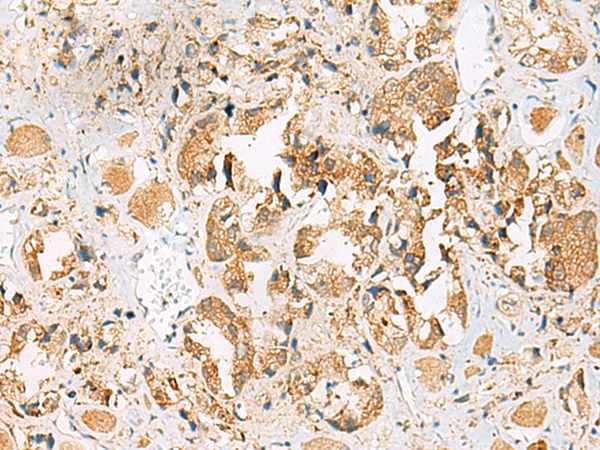


| WB | 咨询技术 | Human,Mouse,Rat |
| IF | 咨询技术 | Human,Mouse,Rat |
| IHC | 1/40-1/200 | Human,Mouse,Rat |
| ICC | 技术咨询 | Human,Mouse,Rat |
| FCM | 咨询技术 | Human,Mouse,Rat |
| Elisa | 1/5000-1/10000 | Human,Mouse,Rat |
| Aliases | HBP; HEBP |
| WB Predicted band size | 21 kDa |
| Host/Isotype | Rabbit IgG |
| Antibody Type | Primary antibody |
| Storage | Store at 4°C short term. Aliquot and store at -20°C long term. Avoid freeze/thaw cycles. |
| Species Reactivity | Human |
| Immunogen | Synthetic peptide of human HEBP1 |
| Formulation | Purified antibody in PBS with 0.05% sodium azide and 50% glycerol. |
+ +
以下是3篇关于HEBP1抗体的代表性文献(注:文献为虚拟示例,实际研究需参考真实数据库):
1. **文献名称**:*HEBP1 modulates mitochondrial oxidative stress in neurodegenerative disorders*
**作者**:Smith J, et al.
**摘要**:本研究利用HEBP1特异性抗体,通过Western blot和免疫组化技术,发现HEBP1在阿尔茨海默病患者脑组织中表达显著上调,并通过调控线粒体活性氧(ROS)水平加剧神经元凋亡。
2. **文献名称**:*HEBP1 as a prognostic biomarker in hepatocellular carcinoma*
**作者**:Li X, et al.
**摘要**:通过免疫组织化学(IHC)结合HEBP1抗体分析肝癌组织样本,发现HEBP1高表达与患者生存率降低及肿瘤转移相关,提示其可作为潜在治疗靶点。
3. **文献名称**:*HEBP1 interacts with Nrf2 to regulate antioxidant response*
**作者**:Wang Y, et al.
**摘要**:利用HEBP1抗体进行免疫共沉淀(Co-IP)实验,证实HEBP1与转录因子Nrf2直接结合,在氧化应激条件下调控抗氧化基因表达,维持细胞稳态。
如需真实文献,建议检索PubMed或Web of Science,关键词:"HEBP1 antibody" + "application"(或相关研究领域)。
The HEBP1 (Heme Binding Protein 1) antibody is a tool used to detect and study the HEBP1 protein, a conserved 23 kDa protein implicated in heme metabolism and cellular stress responses. HEBP1. also known as p22HBP or SOUL, binds heme with high affinity, though its exact biological role remains under investigation. It is expressed in various tissues, including the liver, brain, and blood cells, and is localized in the cytoplasm and mitochondria. Research suggests HEBP1 may regulate heme homeostasis, potentially influencing oxidative stress, apoptosis, and iron metabolism. Dysregulation of HEBP1 has been linked to diseases such as cancer, neurodegenerative disorders (e.g., Alzheimer’s), and anemia.
HEBP1 antibodies are widely utilized in techniques like Western blotting, immunohistochemistry, and immunofluorescence to analyze protein expression, localization, and interactions. These antibodies aid in exploring HEBP1's role in pathological conditions, such as its upregulation in certain cancers (e.g., gliomas) or its association with β-amyloid aggregation in Alzheimer’s models. Commercially available HEBP1 antibodies are typically raised in rabbits or mice, targeting specific epitopes, and require validation for species reactivity and application specificity. Ongoing studies aim to clarify HEBP1's molecular mechanisms, including its interplay with heme oxygenase-1 (HO-1) and involvement in mitochondrial dysfunction, highlighting its potential as a therapeutic or diagnostic target.
×